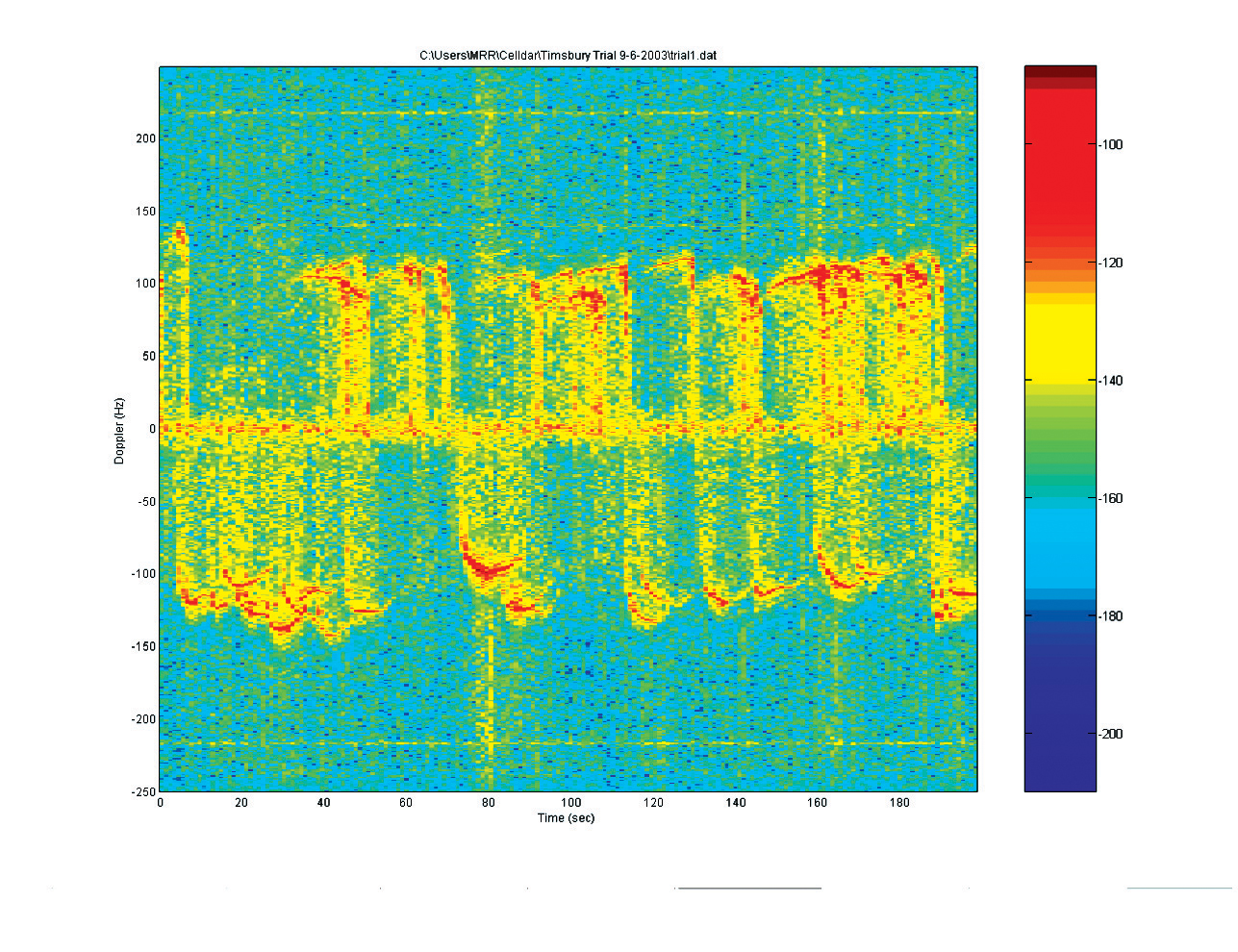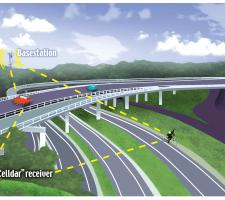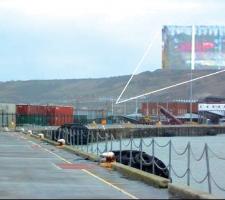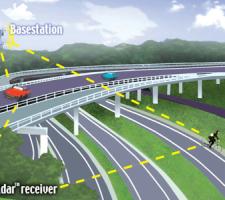
Figure 2: Waterfall plot produced from a trial of Celldar in two-way road traffic
The effect of moving objects on the electromagnetic landscape set up by cellular telephony networks can be detected and interpreted to give real-time traffic data across large geographical areas at low cost. Here, we revisit the Celldar concept
Global economic downturn has pushed public-sector agencies, transport administrations among them, to push even harder for cost efficiencies. Unfortunately, when it comes to transport safety and efficiency the public sector often has to work up to a cost rather than down to a price.We are unlikely to ever see an un-instrumented road built in future and major new infrastructure projects are becoming ever-more expensive - sometimes prohibitively so. Meanwhile there is a push, politically motivated but no less relevant, to increase the safety and improve the operation of our existing roads.
Technological development continues in many respects to outstrip legislative progress. The upshot of this has been written about numerous times in this magazine: multiple systems for different applications are often specified and deployed along the same stretch of road despite the fact that modern detection, monitoring and enforcement systems (and their associated connectivity) have progressed to a point where they are each capable of successfully fulfilling multiple roles. The present situation does not represent value for money to the public sector or the tax-payer.
The ubiquity of cellular communications and telephones in many regions of the world - even lesser-developed ones - offers one possible solution for detection and monitoring applications.
Celldar is a novel passive surveillance system with potential applications in air and littoral water defence, ground movement detection, traffic and harbour monitoring, and homeland security. The system is based on the use of opportunistic transmissions from cellular communications infrastructure and can be used to monitor movement across a whole geographical area. For traffic monitoring applications, Celldar requires little in the way of infrastructure and nothing in-vehicle or in/adjacent to the carriageway. With thousands if not millions of cell phone base stations installed around the world, much of the infrastructure necessary for this type of monitoring is already in place.
Operating principles
Celldar achieves location and classification by detecting passive cell phone transmissions that echo off the surfaces of an object (for example, a vehicle, motorcycle, pedestrian, animal, train, ship and so on). It does not rely on any special equipment being mounted on the object or on the object having some form of cellular connectivity.When a vehicle (or pedestrian, or any other moving object) enters a detection region, the reflected cell phone transmissions are detected by one or more Celldar signal receivers (Figure 1). The moving vehicle causes changes to the frequency and path length of the reflected signals. Based on these changes relative to the positions of the base station and receiver, characteristics such as speed, position and direction of motion can then be calculated. This provides the material for processing into traffic data. Information may be extracted from the signals using off-the-shelf equipment including standard cell phone components, although the signal processing software is bespoke.
Features of Celldar include: transmissions are not required (it is a 'passive' solution), hence there are no licensing or public safety implications; it is not dependent on the numbers of cell phone users or phone calls; it works in all weather conditions and at night; it can detect through foliage; and it has low power requirements.
Celldar data, and in particular analysis of Doppler or 'Waterfall' plot outputs (Figure 2), can show the motion patterns of moving objects, such as their accelerations, decelerations and directions of travel. Detecting a vehicle stopping unexpectedly may indicate the occurrence of an accident or incident. Analysis also makes possible vehicle classification in addition to speeds and vectors. Objects can be tracked although individual vehicles cannot be identified.
Figure 2 is an experimental Waterfall plot produced from an early trial of Celldar in two-way road traffic. The thick horizontal line indicates reflections from stationary objects (including the road surface itself). The lines above and below that show objects moving towards and away from the detector. The 'hook' on the end of each line is related to the shape of the road and also indicates acceleration or deceleration. The distance from the centre indicates speed, and the width of the line from left to right indicates the length of the vehicle. It should be noted that this plot is for illustrative purposes only; in practice, software would extract such identifying features automatically so that there would be no reliance on a human operator.
The Celldar prototype detector is sensitive enough to show the Doppler signature of walking pedestrians. The system can be calibrated for a specific location, for example by calibrating it against a vehicle moving at a constant speed. The algorithm can then detect deviations from this.
Background and history
Contract engineering R&D companyWide-scale data collection and monitoring is the cornerstone of the traffic management, charging and traveller information services that could help to fulfil government transport objectives but there are either gaps in the sensors available to support these needs or they require extensive infrastructure. Hence, the potential for a low-cost technology that requires minimal infrastructure needed to be examined.
The study achieved its objectives, within time and budget, of showing the feasibility of using Celldar. A demonstrator system developed during the programme was used in experimental deployments which confirmed the expected ranges for detecting vehicles. A trial in the Port of Dover in England detected trucks and other vehicles on the A20 road leaving Dover and also on the sea front. In all, the trial covered about two miles of road with five roundabouts. Figure 3 shows the trucks being detected from the Celldar test site, with a vehicle highlighted.
The research then progressed, with Roke carrying out trials on the Isle of Wight. These exercised a demonstrator system developed during the programme. The scope of application for these trials was focused on military applications and in particular to examine the capability of tracking ships. The ship trial was undertaken on the southern coast of the Isle of Wight. The target in this initial maritime trial was a car ferry, which provided a target of convenience that was both timetabled and could be instrumented with a GPS logger. The gathered GPS data was then used to verify the response from Celldar.
Where is it now?
The original Celldar study and its consequent trials have proved the feasibility of using this technique in a variety of both commercial transport and military applications. The demonstrator has been deployed for a range of trials, in different locations and with various target types, ranging from light aircraft through to maritime craft.The research team has further identified potential risks to implementation, the impact of Celldar and an initial business case for deployment as well as highlighting remaining technical issues.
In short, the technique promises useful application in one of two main ways: as a small, short-range roadside vehicle detection system; and as a large-area coverage detection system.
As well as producing a proof of concept demonstrator Roke has patented the original concept.
What next?
The next step is to examine both the remaining technical issues and cost benefit analysis in real-world pilots with roads authorities. The concept needs to be taken further in the following ways: more rigorous trials to validate it further; the creation of a sound business case; and finding and working with development partners for chosen applications.Roke believes there is, in principle, a business case to use Celldar, once proven technically, to: replace and enhance existing monitoring to give much higher levels of network intelligence, especially on rural roads where there is currently little coverage; extend monitoring and incident detection to areas not currently covered, to allow a more rapid response to accidents and other problems; improve embedded systems, such as MIDAS (inductive) loops, by utilising more and new types of data; and deploy new policies, such as redistribution of road space and signal timings to pedestrians.
Performance in highly congested and stationary conditions, as with other sensors, may be a challenge to accuracy and this risk needs to be explored in real-world tests. Trials are also needed to prove theoretical work on sensor timing (for traffic control) and on the volume of vehicles that can be processed. Roadside tests are needed to provide more evidence on outstanding technical questions on coverage, accuracy and classification issues. These are not major risks, however.
Clearly, using Celldar would be a large shift for practitioners in monitoring and control and it needs to be made simple to deploy and install. Early indications of its potentials are strong but proving the technology to more sceptical stakeholders will require the ability to represent Celldar output data in transport terms, for example as maps rather than radar outputs (the 'Waterfall' plot). This is relatively straightforward and is already underway. There is also a need for on-road pilots that address implementation issues such as sensor mounting.
Proving the technology for rural monitoring as a first step would both provide a foundation for Celldar's development for wider applications and potentially give the desired outcomes of reduced rural accidents and congestion.














